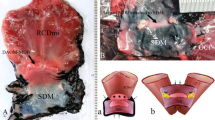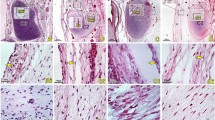Abstract
Purpose
The connective tissue between suboccipital muscles and the cervical spinal dura mater (SDM) is known as the myodural bridge (MDB). However, the adjacent relationship of the different connective tissue fibers that form the MDB remains unclear. This information will be highly useful in exploring the function of the MDB.
Methods
The adjacent relationship of different connective tissue fibers of MDB was demonstrated based upon three-dimensional visualization model, P45 plastinated slices and histological sections of human MDB.
Results
We found that the MDB originating from the rectus capitis posterior minor muscle (RCPmi), rectus capitis posterior major muscle (RCPma) and obliquus capitis inferior muscle (OCI) in the suboccipital region coexists. Part of the MDB fibers originate from the ventral aspect of the RCPmi and, together with that from the cranial segment of the RCPma, pass through the posterior atlanto-occipital interspace (PAOiS) and enter into the posterior aspect of the upper cervical SDM. Also, part of the MDB fibers originate from the dorsal aspect of the RCPmi, the ventral aspect of the caudal segment of the RCPma, and the ventral aspect of the medial segment of the OCI, enter the central part of the posterior atlanto-axial interspace (PAAiS) and fuse with the vertebral dura ligament (VDL), which connects with the cervical SDM.
Conclusions
Our findings prove that the MDB exists as a complex structure which we termed the ‘myodural bridge complex’ (MDBC). In the process of head movement, tensile forces could be transferred possibly and effectively by means of the MDBC. The concept of MDBC will be beneficial in the overall exploration of the function of the MDB.









Similar content being viewed by others
References
Dean NA, Mitchell BS (2002) Anatomic relation between the nuchal ligament (ligamentum nuchae) and the spinal dura mater in the craniocervical region. Clin Anat 15:182–185
Fernández-de-las-Penas C, Cuadrado ML, Arendt-Nielsen L et al (2008) Association of cross-sectional area of the rectus capitis posterior minor muscle with active trigger points in chronic tension-type headache: a pilot study. Am J Phys Med Rehab 87(3):197–203
Grgić V (2007) Cervicogenic headache: etiopathogenesis, characteristics, diagnosis, differential diagnosis and therapy. Lijec Vjesn 129(6–7):230–236
Gao HB, Liu J, Yu SB, Su HJ (2006) A new polyester technique for sheet plastination. J Int Soc Plast 21:7–11
Hack GD, Koritzer RT, Robinson WL et al (1995) Anatomic relation between the rectus capitis posterior minor muscle and the dura mater. Spine 20:2484–2486
Humphreys BK, Kenin S, Hubbard BB et al (2003) Investigation of connective tissue attachments to the cervical spinal dura mater. Clin Anat 16:152–159
Kulkarni V, Chandy MJ, Babu KS (2001) Quantitative study of muscle spindles in suboccipital muscles of human fetuses. Neurol India 49(4):355–359
Kahkeshani K, Ward PJ (2012) Connection between the spinal dura mater and suboccipital musculature: evidence for the myodural bridge and a route for its dissection–a review. Clin Anat 25(4):415–422
Mitchell BS, Humphreys BK, O’Sullivan E (1998) Attachments of the ligamentum nuchae to cervical posterior spinal dura and the lateral part of the occipital bone. J Manip Physiol Ther 21:145–148
Matthew EA, Deanna KB (1999) A proposed etiology of cervicogenic headache: the neurophysiologic basis and anatomic relationship between the dura mater and the rectus posterior capitis minor muscle. J Manip Physiol Ther 22:534–539
Pontell ME, Scali F, Enix DE et al (2013) Histological examination of the human obliquus capitis inferior myodural bridge. Ann Anat 195(6):522–526
Pontell ME, Scali F, Marshall E et al (2013) The obliquus capitis inferior myodural bridge. Clin Anat 26:450–454
Peck D, Buxton DF, Nitz A (1984) A comparison of spindle concentrations in large and small muscles acting in parallel combinations. J Morphol 180(3):243–252
Park JS, Chung MS, Shin DS et al (2009) Sectioned images of the cadaver head including the brain and correspondences with ultrahigh field 7.0 T MRIs. Proc IEEE 97(12):1988–1996
Rix GD, Bagust J (2001) Cervicocephalic kinesthetic sensibility in patients with chronic, nontraumatic cervical spine pain. Arch Phys Med Rehabil 82(7):911–919
Scali F, Marsili ES, Pontell ME et al (2011) Anatomical connection between the rectus capitis posterior major and the dura mater. Spine 36(25):E1612–E1614
Scali F, Pontell ME, Enix DE (2013) Histological analysis of the rectus capitis posterior major’s myodural bridge. Spine J 13:558–563
Sui HJ, Henry RW (2007) Polyester plastination of biological tissue: hoffen P45 technique. J Int Soc Plast 22:78–81
Xu Q, Yu SB, Zheng N et al (2015) Head movement, an important contributor to human cerebrospinal fluid circulation. Sci Rep 19(6):31787
Yuan XY, Yu SB, Liu C et al (2017) Correlation between chronic headaches and the rectus capitis posterior minor muscle: a comparative analysis of cross-sectional trail. Cephalalgia 37(11):1051–1056
Zheng N, Yuan XY, Chi YY et al (2017) The universal existence of myodural bridge in mammals: an indication of a necessary function. Sci Rep 7:8248
Zheng N, Yuan XY, Li YF et al (2014) Definition of the to be named ligament and vertebrodural ligament and their possible effects on the circulation of CSF. PLoS One 9(8):e103451
Zheng N, Chi YY, Yang XH et al (2018) Orientation and property of fibers of the myodural bridge in humans. Spine J 18(6):1081–1087
Acknowledgments
The authors thank Min Suk Chung for his wonderful suggestions in designing the present study. The authors also gratefully acknowledge those who donated their bodies and their families. This study was supported Natural Science Foundation of China (NSFC31571234) awarded to Hong-Jin Sui(Joy: PI) and Natural Science Foundation of China (NSFC31600972) awarded to Nan Zheng(Joy: PI).
Author information
Authors and Affiliations
Contributions
SB Yu and HJ Sui: Project development. N Zheng, YL Li, TY Liu, LX Zhang, YY Ge, NX Wang, ZH Zhang and L Cai: Data collection and analysis. YY Chi, JF Zhang: Data analysis N Zheng and BS Chung: Manuscript writing. SB Yu, HJ Sui, OC Samuel and MS Chung: Manuscript editing.
Corresponding authors
Ethics declarations
Conflict of interest
The authors declare no conflicts of interest associated with this study.
Ethical approval
All the procedures performed in this study which involvs human participants were in accordance with the ethical standards of the institutional and/or national research committee and with the 1964 Helsinki declaration and its later amendments or comparable ethical standards.
Additional information
Publisher's Note
Springer Nature remains neutral with regard to jurisdictional claims in published maps and institutional affiliations.
Rights and permissions
About this article
Cite this article
Zheng, N., Chung, B.S., Li, YL. et al. The myodural bridge complex defined as a new functional structure. Surg Radiol Anat 42, 143–153 (2020). https://doi.org/10.1007/s00276-019-02340-6
Received:
Accepted:
Published:
Issue Date:
DOI: https://doi.org/10.1007/s00276-019-02340-6




